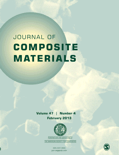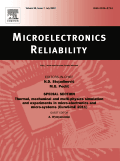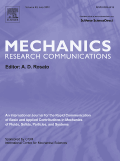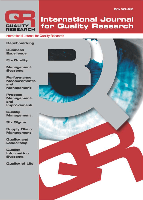
Journal of Failure Analysis and Prevention
Scope & Guideline
Unraveling Failure Mechanisms for a Safer Tomorrow
Introduction
Aims and Scopes
- Failure Analysis Methodologies:
The journal emphasizes various methodologies for analyzing failures, including metallurgical investigations, finite element analysis, and statistical modeling, to determine root causes and mechanisms of failure. - Material and Structural Integrity:
Research often focuses on the integrity of materials and structures under different environmental and operational conditions, highlighting how various factors contribute to material degradation and failure. - Industry Applications:
The journal covers a wide range of industry applications, including aerospace, automotive, energy, and manufacturing, providing insights into failures specific to these sectors and offering practical solutions. - Preventive Strategies and Design Improvements:
There is a consistent focus on developing and proposing preventive strategies, design improvements, and maintenance practices aimed at reducing the likelihood of failures in various systems. - Interdisciplinary Research:
The journal encourages interdisciplinary research that combines insights from engineering, materials science, and applied physics to address complex failure issues.
Trending and Emerging
- Artificial Intelligence and Machine Learning Applications:
There is a rising trend in the application of AI and machine learning techniques for predictive maintenance and failure diagnostics, showcasing the journal's adaptation to technological advancements. - Advanced Materials and Composites Analysis:
Research on advanced materials, including composites and alloys, is gaining traction, emphasizing their unique failure mechanisms and performance under various conditions. - Sustainability and Environmental Impact:
Increasing attention is being given to the sustainability aspects of materials and processes, with papers discussing failure analysis in the context of environmental impact and resource efficiency. - Multi-Scale and Multi-Physics Modeling:
Emerging themes include multi-scale modeling approaches that integrate various physical phenomena to predict failure more accurately, reflecting the complexity of real-world applications. - Failure Prevention Innovations:
There is a noticeable increase in research focused on innovative failure prevention strategies, including real-time monitoring systems and advanced material treatments.
Declining or Waning
- Traditional Failure Analysis Techniques:
There has been a noticeable decline in the publication of papers focused solely on traditional failure analysis techniques without integration of advanced technologies such as AI and machine learning. - Basic Materials Testing:
Papers that solely discuss basic materials testing, such as tensile or hardness testing without context of failure analysis applications, are becoming less frequent as more complex analyses are favored. - Generalized Case Studies:
Publications that offer generalized case studies without specific insights or advanced methodologies are waning, as the journal shifts towards more detailed and technical analyses. - Focus on Single Failure Modes:
Research focusing on single failure modes is decreasing in favor of studies that address multiple failure modes or interdisciplinary approaches that consider various factors. - Historical Failures Documentation:
While historical case studies have been valuable, there is a declining trend in documenting failures merely for historical context without linking them to modern practices or improvements.
Similar Journals

JOURNAL OF COMPOSITE MATERIALS
Connecting Researchers and Professionals in CompositesJOURNAL OF COMPOSITE MATERIALS, published by SAGE PUBLICATIONS LTD, is a premier academic journal dedicated to advancing the field of composite materials. With a long-standing history since 1967, this journal serves as a vital platform for researchers and professionals in the areas of ceramics and composites, materials chemistry, mechanical engineering, and mechanics of materials. The journal's impact is further underscored by its Q2 quartile ranking in various categories as of 2023, alongside notable Scopus rankings in multiple engineering and material science disciplines. Though it currently lacks Open Access options, its rigorous peer-review process ensures the high quality and relevance of its published research. This journal is instrumental in fostering innovation and promoting collaboration among academics and industry professionals, making it essential reading for anyone involved in materials science and engineering.

Structural Integrity and Life-Integritet I Vek Konstrukcija
Enhancing Safety and Reliability in Construction.Structural Integrity and Life - Integritet I Vek Konstrukcija is a prominent open-access journal dedicated to advancing the fields of Civil and Structural Engineering, Mechanics of Materials, and Safety, Risk, Reliability, and Quality. Published by the SOC STRUCTURAL INTEGRITY & LIFE, this journal has been disseminating high-quality research since 2001 from its base in Belgrade, Serbia. The journal's commitment to open access ensures that vital research is freely accessible to a global audience, fostering collaboration and innovation within the academic community. With an impressive categorization in the 2023 quartiles, including Q2 in Metals and Alloys and Q3 in related fields, Structural Integrity and Life stands as a vital resource for researchers, professionals, and students striving to enhance understanding and applications in structural integrity and material performance. The journal invites contributions that address critical issues in the field, pushing the boundaries of knowledge and practical applications, and welcomes both empirical studies and theoretical discussions that can drive forward the next generation of engineering solutions.

Journal of Advanced Joining Processes
Exploring the Science of Seamless IntegrationJournal of Advanced Joining Processes, published by ELSEVIER, is a pioneering open-access journal dedicated to the dissemination of high-quality research in the field of joining processes, spanning across chemical, mechanical, and materials engineering. With its ISSN 2666-3309, this journal has rapidly established a significant presence in the academic community, achieving Q1 rankings in several categories, including Chemical Engineering, Mechanical Engineering, and Mechanics of Materials, as of 2023. Furthermore, it holds impressive Scopus rankings, with Engineering (miscellaneous) ranked #30 out of 204, indicating its influence and importance within the interdisciplinary landscape of engineering. As an open-access platform since 2020, the Journal of Advanced Joining Processes fosters the free exchange of ideas and research findings, thereby supporting professionals, researchers, and students in advancing their knowledge and practices in cutting-edge joining techniques. With converged years from 2020 to 2024, this journal is poised to remain at the forefront of the evolving field of joining technologies, appealing to a global readership eager to explore innovative solutions and methodologies.

MICROELECTRONICS RELIABILITY
Advancing the Future of Microelectronics ReliabilityMICROELECTRONICS RELIABILITY, published by PERGAMON-ELSEVIER SCIENCE LTD, is a pivotal journal that serves the advancing field of microelectronics and materials reliability. With its ISSN 0026-2714 and E-ISSN 1872-941X, this journal has been at the forefront of disseminating research since its inception in 1962 and is set to continue exploring cutting-edge topics through 2024. The journal holds a respectable presence across several categories, achieving a Q3 ranking in areas such as Atomic and Molecular Physics and Electrical and Electronic Engineering, highlighting its broad interdisciplinary appeal, while also ranking in the Q2 category for Safety, Risk, Reliability, and Quality, which speaks to its commitment to ensuring standards in technological advancements. Access to this journal is subscription-based, making it an essential resource for researchers, professionals, and students seeking reliable information and data regarding electronic material performance and reliability assessment. Located in Kidlington, Oxford, UK, MICROELECTRONICS RELIABILITY is dedicated to advancing the field and addressing the critical issues associated with the reliability of microelectronic devices, thereby supporting innovations that shape our technological future.

MECHANICS RESEARCH COMMUNICATIONS
Advancing the Frontiers of Mechanics and MaterialsMECHANICS RESEARCH COMMUNICATIONS, published by PERGAMON-ELSEVIER SCIENCE LTD, is a prestigious journal in the fields of Civil and Structural Engineering, Condensed Matter Physics, Materials Science, and Mechanical Engineering. With an ISSN of 0093-6413 and E-ISSN of 1873-3972, it has made significant contributions to the understanding and advancement of mechanics and materials since its inception in 1974. The journal is well-regarded in academia, holding a Q2 ranking across multiple categories as of 2023, and ranking in the 65th percentile for Mechanical Engineering. Researchers and professionals benefit from its peer-reviewed content, which includes a wide range of articles from fundamental research to applied technological developments. Although currently not an open access journal, it remains a vital resource for those focused on innovating within the engineering and materials science domains. With its established legacy, MECHANICS RESEARCH COMMUNICATIONS continues to shape the discourse in mechanics and engineering, making it essential reading for students and practitioners alike.

METALURGIJA
Transforming materials research with cutting-edge findings.METALURGIJA is a distinguished open-access journal published by the Croatian Metallurgical Society, dedicated to advancing the field of metallurgical sciences and engineering. With an ISSN of 0543-5846 and E-ISSN of 1334-2576, this journal has been serving the academic community since its inception, offering valuable insights into condensed matter physics, materials chemistry, mechanics of materials, and metals and alloys. As of 2023, it ranks in Q3 in the fields of condensed matter physics, materials chemistry, and mechanics of materials, and Q2 in metals and alloys, reflecting its engagement with contemporary research and emerging trends. The journal's open-access policy, in place since 2002, ensures that high-quality research is accessible to a global audience, fostering collaboration and knowledge sharing. Located in Zagreb, Croatia, METALURGIJA aims to bring together researchers, industry professionals, and students alike to contribute to systemic advancements in metallurgical research and applications, ultimately enhancing innovation within the materials science community.

International Journal of Rotating Machinery
Elevating Knowledge in Rotating Machinery ApplicationsThe International Journal of Rotating Machinery, published by Hindawi Ltd, is a prominent open-access journal dedicated to advancing research and innovation in the fields of Mechanical Engineering and Industrial and Manufacturing Engineering. Since its inception in 1994, the journal has been committed to disseminating high-quality research articles that explore the mechanics, performance, and design of rotating machinery, which are critical in various industrial applications. The journal has established itself within the academic community, earning a Q3 category ranking in both its specialized fields as of 2023. With a robust history spanning converged years from 1994 to 2024, and an active presence in major indexing databases, it serves as an essential resource for researchers, practitioners, and students keen to stay at the forefront of engineering advancements. Notably, the journal's open access policy ensures that all articles are freely available, fostering greater collaboration and sharing of knowledge within the global engineering community.

Bridge Structures
Elevating Standards in Bridge Structures ResearchBridge Structures is an esteemed academic journal dedicated to the field of structural engineering, particularly focusing on the design, analysis, and maintenance of bridge systems. Published by IOS PRESS, a reputable publisher known for its contributions to various scientific fields, the journal serves as an integral platform for disseminating innovative research and advancements within the domain. With an ISSN of 1573-2487 and an E-ISSN of 1744-8999, Bridge Structures has established itself over the years—covering contributions from 2005 to 2024. The journal has attained a commendable ranking within the Q3 category in Building and Construction and holds a position within the 28th percentile among its peers according to the Scopus rankings. Though the journal operates on a subscription basis, its commitment to advancing engineering knowledge is paramount, making it essential reading for researchers, practitioners, and students eager to deepen their understanding of bridge engineering. The journal not only explores theoretical advancements but also emphasizes practical applications, providing a well-rounded perspective on current challenges and solutions in the field of bridge structures.

Journal of Reliability and Statistical Studies
Fostering Excellence in Statistical Analysis and Reliability ResearchJournal of Reliability and Statistical Studies, published by RIVER PUBLISHERS, is a vital resource for researchers and professionals engaged in the fields of analysis, statistics, and numerical methods. With an ISSN of 0974-8024 and E-ISSN 2229-5666, this journal has carved a niche since its inception, converging from 2019 to 2024 to deliver cutting-edge research. The journal is recognized in the academic community, demonstrated by its rankings in Scopus: Mathematics (Analysis: Rank #108/193, Percentile 44; Statistics and Probability: Rank #170/278, Percentile 39; Numerical Analysis: Rank #58/88, Percentile 34). Despite being categorized as Q4 in its field for 2023, it aims to cultivate a robust platform for innovative studies that push the boundaries of reliability and statistical methodologies. Researchers will find value in its commitment to disseminating both theoretical and practical advancements, making it an essential journal for students and scholars striving for excellence in statistical analysis and reliability engineering.

International Journal for Quality Research
Connecting Scholars and Practitioners for Quality Advancement.International Journal for Quality Research (ISSN: 1800-6450; E-ISSN: 1800-7473) is a prestigious peer-reviewed journal published by the Faculty of Engineering, University of Kragujevac, Serbia. Since its inception in 2007 as an Open Access platform, it has continually aimed to disseminate high-quality research in the fields of Industrial and Manufacturing Engineering, Management Science and Operations Research, and Safety, Risk, Reliability and Quality. With a notable impact factor reflected in its quartile rankings—Q2 in Industrial and Manufacturing Engineering and Q3 in both Management Science and Safety—this journal serves as a vital resource for scholars and practitioners seeking to advance their knowledge and contribute to ongoing dialogues in quality research. The journal boasts impressive Scopus rankings, positioning it favorably among its peers, and continues to attract diverse contributions that foster innovation and best practices in quality management. The converged years of publication from 2012 to 2024 indicate a sustained commitment to addressing the evolving challenges and opportunities within its domains, making it an essential reading for any serious researcher or professional in the field.